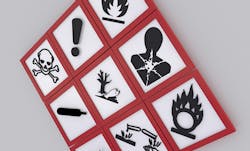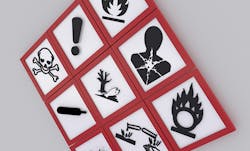August 3, 2015: effective date for the new Occupational Safety and Health Administration (OSHA) final rules for working in confined spaces. Do these apply to you? You be the judge, but know you will be judged by OSHA if you get sideways with the regulations and you or an employee is injured, or worse, while on the job.
For the record: we perform a ton of easily recognized confined space entry work while testing potable and fire line backflow preventers. Previously certified for Confined Space Entry (CSE): facilities like landfills required permitted CSE due to known dangers from gasses that have the potential to fill underground vaults and displace oxygen.
With the new OSHA regs pending, it was time to get recertified and trained. From my perspective, that meant seeking out independent outside training and passing a written test.
In the past, it has not been uncommon for us to encounter underground vaults deficient in oxygen (O2). Our 4-gas meter alarm sounds if O2 falls below 19.5% (20.9% O2 is normal in air).
We have seen vaults test to 0% O2! A portable 12-volt DC to 120-volt AC inverter enables us to quickly enable a blower and a lengthy flexible duct permits rapid ventilation of the pit. Air sampling is taken at various elevations and ventilation is continuous until the work has been completed and all personnel are safely out of the confined space. Air sampling is also continuous while personnel are in the confined space.
OSHA estimates that there are a yearly average of six fatalities and 812 injuries associated with CSE and that full compliance with the final CSE rules can reduce the statistics by 96%.
Our instructor worked logically through the new OSHA rule. I learned new information along with review of prior knowledge and want to share information from my notes. The prior CSE rules were vague with not much guidance for employers. The new rules include provisions to:
- Identify confined spaces and any known hazards.
- Grant you, the employer, the authority to prevent unauthorized entry.
- Elimination of hazards to avoid exposure.
- Utilization of a permit system when the hazard, or potential hazard, cannot be removed. (Think about this for a moment — where do we, as mechanical contractors encounter this type of non-removable hazard? — I’ll get to this in a bit.)
- Utilization of acceptable equipment to test and enhance safety.
- Last, but not least, establish etched-in-stone rules for rescue should an emergency occur and extraction becomes necessary.
Rule No. 1: OSHA states employers must have a “competent person” determine if the area where work will be performed is, or is not, a CSE and additionally, if this requires a permit. The term competent person means they are trained and that was precisely why I wanted us to have an independent outside trainer. Liability issues here can be business-killers and an outside authority as trainer removes (from my viewpoint) any in-house training as being suspect should a crisis ever occur. Fortunately, the permit required need only be an internal document and not one to be obtained at a municipal office that cost both time and money.
No less than two: the attendant, or topside person, and the entrant or worker-bee.
Attendant: The attendant must be, well, attendant trained, and constantly monitor and communicate with the entrant. At no time can the attendant wander off while an entrant is in the Confined Space (CS). Constant monitoring of air is required to test for O2, CO (carbon monoxide), H2SO4 (hydrogen sulfide), and LEL (lower explosive limit for combustible gasses).
Has the authority to maintain security surrounding the entry-point and to order the entrant evacuation, if deemed necessary. Use traffic control devices (like cones) as needed to maintain safety and clearance. This authority supersedes all others on the jobsite, including anyone who intrudes onto the area or creates a known hazard (vehicle exhaust as an example). The attendant must also accept the responsibility to direct rescue operations and never, never, ever enter the CS to attempt a rescue. Only trained CS rescue personnel are to perform the extraction.
Entrant: The entrant, first and foremost, must be able to identify known hazards; use Personal Protective Equipment (PPE); communicate with the attendant; exit if so ordered to do so; and alert the attendant when any prohibited condition exists.
Controlling Contractor: This person is ultimately in charge of the attendant and entrant.
Rule No. 2: Confined Space vs. Permit Required Confined Space (PRCS).
CS = Limited access; large enough to perform the work required; and not designed for permanent occupancy.
PRCS = Has, or has the potential for, a known hazard (physical or atmospheric); potential for engulfment; potential to become entrapped.
Read over PRCS again because that is what mechanical contractors will be dealing with. A water or sewer line runs through that underground vault: engulfment hazard potential. An open ditch more than 4 feet deep: Entrapment hazard is present and the potential for gases heavier than O2 to settle in for someone to take a dirt-nap. Like it or not, we fall squarely under the PRCS rules.
Rule No 3: The Permit. The good news is this can be your own document. The bad news is if it’s not in written form, it doesn’t exist. Here’s what our instructor said must be included:
- Designate attendant.
- Designate entrant.
- Record the four gasses and their levels (for example: O2 = 20.9%).
- Was ventilation required? Re-record gasses and their levels.
- Was ventilation constant and were gasses sampled at different levels?
- Identify any known hazards.
- Have written emergency procedure with contact info (standby and call 911 for example).
I know some of you are thinking a ¾” potable water line break doesn’t exactly constitute a rapid engulfment hazard in a confined space. Until the day comes when you are face-to-face with a suddenly-separated ¾”-ID 100-PSI water line while working in a tight space, been there — experienced that, it’s easy to be complacent regarding safety.
Extracting yourself and locating the curb-box to turn off the water under those emergency conditions will fray your nerves. Imagine that’s an 8” Reduced Pressure Zone (RPZ) BFP in a vault and during the annual testing procedure the relief port dumps wide-open. Or you’re in a sewage pit attempting to clear a clog when it breaks free and floods the pit. Crawl spaces and attics are often CS or PRCS work zones under the new OSHA ruling.
Work smart and stay safe — get trained. Following the new OSHA rules will ensure you and your employees have a greatly enhanced opportunity for work-place safety.
All Dave Yates material in print and on Contractor's Website is protected by Copyright 2015. Any reuse of this material (print or electronic) must first have the expressed written permission of Dave Yates and Contractor magazine. Please contact via e-mail at: [email protected].
About the Author
Dave Yates
Dave Yates material in print and on Contractor’s Website is protected by Copyright 2017. Any reuse of this material (print or electronic) must first have the expressed written permission of Dave Yates and Contractor magazine.

